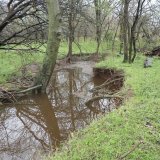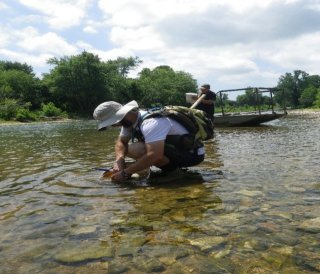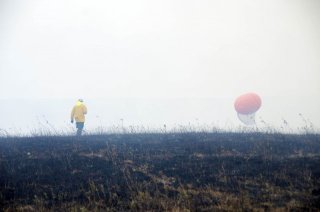EPA Research in Oklahoma
EPA researchers are working hard to protect communities across the nation. Learn about some of the work EPA researchers are doing in Oklahoma.
- Protecting Groundwater Resources within the Arbuckle-Simpson Aquifer
- Response to Ricin Contamination
- Impacts of Enhanced Aquifer Recharge on Groundwater Quality and Quantity
- Working with Oklahoma to Restore Valuable Water Resources
- Partnering with Tribes to Deploy Air Sensors in Communities
- Performance Evaluation of Popular Air Sensors
- Smoke Management Practices for Prescribed Burns in Flint Hills Prairie
- Community Air Quality Monitoring
- Groundwater Research at EPA's Ada Facility
For more EPA work, see EPA in Oklahoma.
Protecting Groundwater Resources within the Arbuckle-Simpson Aquifer

In south central Oklahoma, where water and rainfall can be scarce, the Arbuckle-Simpson Aquifer is a critical water source. For decades, EPA scientists in Ada, Oklahoma, have been working with federal, tribal, state, and academic partners to understand the impacts of human activities on the aquifer’s water quality and quantity. Read Protecting Groundwater Resources within the Arbuckle-Simpson Aquifer in Oklahoma.
Response to Ricin Contamination
Ricin is a deadly biological toxin that is easily produced from castor beans, making it one of the most worrisome biological threat agents. In response to an increase in ricin incidents occurring between 2013-2019, including an incident in Oklahoma, EPA researchers in the Office of Research and Development (ORD) developed innovative solutions that led to significantly shortened response times and decreased costs and resources required for ricin incidents. This work provided the federal government with important new capabilities for helping states and local communities respond to ricin incidents.
Impacts of Enhanced Aquifer Recharge on Groundwater Quality and Quantity
The Arbuckle-Simpson Aquifer in south central OK, a primary source of drinking water for tens of thousands of people, is increasingly being stressed by growing water demands and shifting weather patterns. EPA ORD has been working with federal, Tribal, state and academic partners, including the City of Ada and the Chickasaw Nation, to understand human impacts on the aquifer’s water quality and quantity and to understand the geological controls on groundwater flow. The research will inform these and other partners about risks to groundwater quality and aquifer recharge in rural settings.
Working with Oklahoma to Restore Valuable Water Resources

To understand the qualities that must be present to support a healthy waterbody, scientists must evaluate the biological criteria of the water. EPA researchers worked with partners in Oklahoma to refine their current biological indices. The goal of this effort was to improve bioassessments based on fish and macroinvertebrate assemblages in wadeable streams throughout the state. Read EPA Researchers Work with Oklahoma Partners to Evaluate Ecological Conditions of Wadeable Streams and Restore Valuable Water Resources.
Partnering with Tribes to Deploy Air Sensors in Communities
Partnerships can advance citizen science efforts that use innovative approaches to protect communities from health risks such as air pollution. EPA is working with tribal communities to deploy air sensors in a variety of venues, including on tribal lands, to help people learn about air quality issues in their communities. EPA scientists partnered with the Cherokee Nation of Oklahoma, Catawba Indian Nation, the Seminole Tribe of Florida, and other state and local partners to host an air sensor collocation shelter. Read EPA Partners with Tribes to Deploy Air Sensors in Communities.
Performance Evaluation of Popular Air Sensors
There is wide interest from air monitoring agencies, researchers, and community groups in deploying smaller, more portable air sensor technologies for community-scale air monitoring projects. First, air sensors need to be thoroughly evaluated in order to understand their limitations and data quality. EPA partnered with six air monitoring agencies, including Oklahoma Department of Environmental Quality, to operate five air sensor types alongside standard regulatory monitors so that data could be compared.
Smoke Management Practices for Prescribed Burns in Flint Hills Prairie

Central Kansas is home to the largest remaining tallgrass prairie in North America with five million acres in Kansas and portions of Nebraska and Oklahoma. Fires were once a natural occurrence, but now they are intentionally set during prescribed burns, primarily in the spring. The fires burn the invasive plants and rejuvenate the soil, which encourages growth of native grasses. However, the smoke plumes from the fires can contribute to air pollution in nearby communities and farther downwind. EPA researchers are conducting research to support best smoke management practices for prescribed burns of prairies to reduce the impact of smoke on communities. Read Novel Air Measurement Technology Supports Smoke Management Practices for Prescribed Burns.
Community Air Quality Monitoring
Oklahoma City was included in the Village Green Project, which featured the installation of novel air and weather measurement stations developed by EPA ORD scientists. The stations were compact, solar-powered systems incorporating air and weather instrumentation into a park bench. The project built upon the need to enhance transparency and showcased next-generation air measurement technology by providing quality-assured data to the public on a near real-time basis, updating to a public website every minute. The station was transferred to OK DEQ a few years ago and is being used by the state for technology R&D purposes.
Groundwater Research at EPA's Ada Facility
The Robert S. Kerr Environmental Research Center (RSKERC) in Ada, OK, is a major federal research facility operated by the Office of Research and Development (ORD). ORD scientists in Ada conduct research on groundwater, subsurface contaminant remediation, and ecosystem restoration. ORD activities have significant impacts on the Ada region, including advancing science, positively impacting the economy, and contributing to the regional community. Read Over 50 Years of Groundwater Research at EPA's Kerr Lab in Ada, OK.
